Analysis and Comprehensive Evaluation of Water Use Efficiency in China
Abstract
1. Introduction
2. Evaluation Index System and Analysis of Water Use Efficiency in China
2.1. Economic Water Use Efficiency Index
2.2. Agricultural Water Use Efficiency Index
2.3. Industrial Water Use Efficiency Index
2.4. Urban/Domestic Water Use Efficiency Index
2.5. Environmental Water Use Efficiency Index
3. Modeling the Comprehensive Index of Water Utilization Efficiency
4. Results and Discussion
4.1. Results
4.2. Discussion
4.2.1. Analysis on the Overall Efficiency of Water Use in Each Province
4.2.2. Analysis on the Overall Efficiency of Water Use in Each Province
4.2.3. Analysis on the Overall Efficiency of Water Use in Each Province
5. Conclusions
- (1)
- The evaluation index of overall water-use efficiency covers all areas of water use, including all industries. This broad analysis and regional comparison across all provinces provide a sound understanding of the effectiveness of water management at the national, regional, and sector levels.
- (2)
- This paper gives the detailed steps of the combined projection pursuit cluster and accelerating genetic algorithm method. The method is applied to an analysis of water use in China. Each province is ranked according to its overall water-use efficiency, and contribution of each index to the overall result can be reflected by the optimized projection direction. This method is easily applicable, gives accurate and objective evaluation results, and demonstrates projection pursuit as a powerful tool for a variety of comprehensive evaluation applications.
- (3)
- The projection pursuit cluster model can be mapped to low-dimensional subspace by finding the best projection direction, which is advantageous to the aggregation process and the comprehensive assessment of the sample. A shortcoming of this model is that the best projection direction is dependent on the optimization algorithm and is computationally expensive to calculate.
Author Contributions
Funding
Acknowledgments
Conflicts of Interest
References
- Wan, Y.H.; Zhang, G.Y. Thoughts on Accelerating the Development and Utilization of Unconventional Water Sources. China Water Resour. 2012, 17, 9–10. (In Chinese) [Google Scholar]
- Wang, X.Q. A study on regional difference of fresh water resources shortage in China. J. Nat. Resour. 2001, 16, 516–520. [Google Scholar]
- Abu-Allaban, M.; El-Naqa, A.; Jaber, M.; Hammouri, N. Water scarcity impact of climate change in semi-arid regions: A case study in mujib basin, Jordan. Arab. J. Geosci. 2015, 8, 951–959. [Google Scholar] [CrossRef]
- Kahil, M.T.; Dinar, A.; Albiac, J. Modeling water scarcity and droughts for policy adaptation to climate change in arid and semiarid regions. J. Hydrol. 2015, 522, 95–109. [Google Scholar] [CrossRef]
- Wang, H.X.; Zhang, L.; Dawes, W.R.; Liu, C.M. Improving water use efficiency of irrigated crops in the North China Plain-measurements and modelling. Agric. Water Manag. 2001, 48, 151–167. [Google Scholar] [CrossRef]
- Wallace, J.S. Increasing agricultural water use efficiency to meet future food production. Agric. Ecosyst. Environ. 2000, 82, 105–119. [Google Scholar] [CrossRef]
- Xu, Y. A study on the evaluation index system of agricultural resources effective utility. Prog. Geogr. 2001, 20, 240–246. [Google Scholar]
- Lilienfeld, A.; Asmild, M. Estimation of excess water use in irrigated agriculture: A data envelopment analysis approach. Agric. Water Manag. 2007, 94, 73–82. [Google Scholar] [CrossRef]
- Andre, F.J.; Herrero, I.; Riesgo, L. A modified DEA model to estimate the importance of objectives with an application to agricultural economics. Omega 2010, 38, 371–382. [Google Scholar] [CrossRef]
- Varghese, S.K.; Veettil, P.C.; Speelman, S.; Buysse, J.; Van Huylenbroeck, G. Estimating the causal effect of water scarcity on the groundwater use efficiency of rice farming in South India. Ecol. Econ. 2013, 86, 55–64. [Google Scholar] [CrossRef]
- Dupoue, A.; Brischoux, F.; Angelier, F.; DeNardo, D.F.; Weight, C.D.; Lourdais, O. Intergenerational trade-off for water may induce a mother-offspring conflict in favour of embryos in a viviparous snake. Funct. Ecol. 2015, 29, 414–422. [Google Scholar] [CrossRef]
- Binet, M.E.; Carlevaro, F.; Paul, M. Estimation of residential water demand with imperfect price perception. Environ. Resour. Econ. 2014, 59, 561–581. [Google Scholar] [CrossRef]
- Li, W.Y.; Zhang, B.; Li, R.Z.; Chang, X.P.; Jing, R.L. Favorable alleles for stem water-soluble carbohydrates identified by association analysis contribute to grain weight under drought stress conditions in wheat. PLoS ONE 2015, 10, e0119438. [Google Scholar] [CrossRef] [PubMed]
- Raskin, P.D.; Hansen, E.; Margolis, R.M. Water and sustainability: Global patterns and long-range problems. Nat. Resour. Forum 1996, 20, 1–15. [Google Scholar] [CrossRef]
- Zhu, R.Q. Case study on Chinese industrial water use efficiency and water saving potential. J. Ind. Technol. Econ. 2007, 26, 48–51. [Google Scholar]
- Sun, A.J.; Dong, Z.C.; Wang, D.Z. Prediction of technical efficiency and water consumption of industrial water in China based on time series. J. China Min. Univ. Technol. 2007, 36, 547–552. [Google Scholar]
- Moglia, M.; Sharma, A.K.; Maheepala, S. Multi-criteria decision assessments using Subjective Logic: Methodology and the case of urban water strategies. J. Hydrol. 2012, 452, 180–189. [Google Scholar] [CrossRef]
- Fang, S.B.; Jia, R.B.; Shen, J. Study on driving factors and regulation of urban domestic water use efficiency. Yellow River 2013, 35, 47–50. (In Chinese) [Google Scholar]
- Lee, M.; Tansel, B.; Balbin, M. Urban Sustainability Incentives for Residential Water Conservation: Adoption of Multiple High Efficiency Appliances. Water Resour. Manag. 2013, 27, 2531–2540. [Google Scholar] [CrossRef]
- Landa-Cansigno, O.; Behzadian, K.; Davila-Cano, D.I.; Campos, L.C. Performance assessment of water reuse strategies using integrated framework of urban water metabolism and water-energy-pollution nexus. Environ. Sci. Pollut. Res. Int. 2019. [Google Scholar] [CrossRef]
- Ma, X.L.; Li, C.; Zhao, Q.M.; Long, A.H.; Qiao, W. Research on ecological water conservation and management in Sinkiang inland river area based on game theory. Manag. Rev. 2017, 29, 235–243. (In Chinese) [Google Scholar]
- Jiang, Z.Y.; Li, X.Y.; Ma, Y.J. Water and energy conservation of rainwater harvesting system in the Loess Plateau of China. J. Integr. Agric. 2013, 12, 1389–1395. [Google Scholar] [CrossRef]
- Cao, Q.P.; Dong, S.F.; Luo, Y.Q.; Su, G.J. Evaluation of network performance using genetic projection pursuit model weighted method. Comput. Simul. 2010, 27, 103–106. [Google Scholar]
- Fu, Q. Projection Pursuit Model Principle and Its Application; Science Press: Beijing, China, 2006; pp. 15–18. (In Chinese) [Google Scholar]
- Koichi, O.; Mari, A.; Yoshihiko, M. Is the default of 2 liters for daily per-capita water consumption appropriate? A nationwide survey reveals water intake in Japan. J. Water Health 2018, 16, 562–573. [Google Scholar]
- Lampert, D.J.; Cai, H.; Elgowainy, A. Wells to wheels: Water consumption for transportation fuels in the United States. Energy Environ. Sci. 2016, 9, 787–802. [Google Scholar] [CrossRef]
- Avni, N.; Fishbain, B.; Shamir, U. Water consumption patterns as a basis for water demand modeling. Water Resour. Res. 2015, 51, 8165–8181. [Google Scholar] [CrossRef]
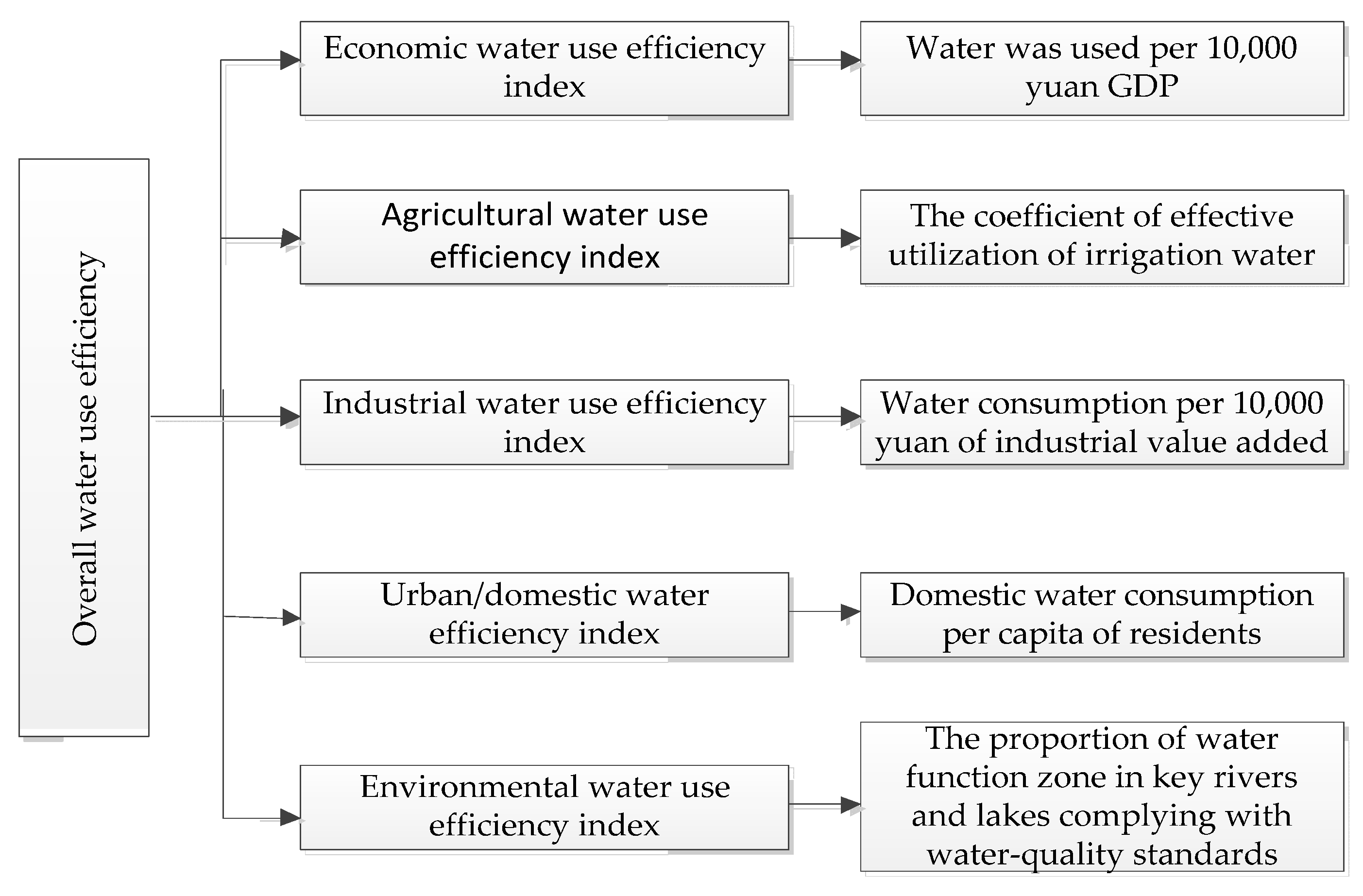
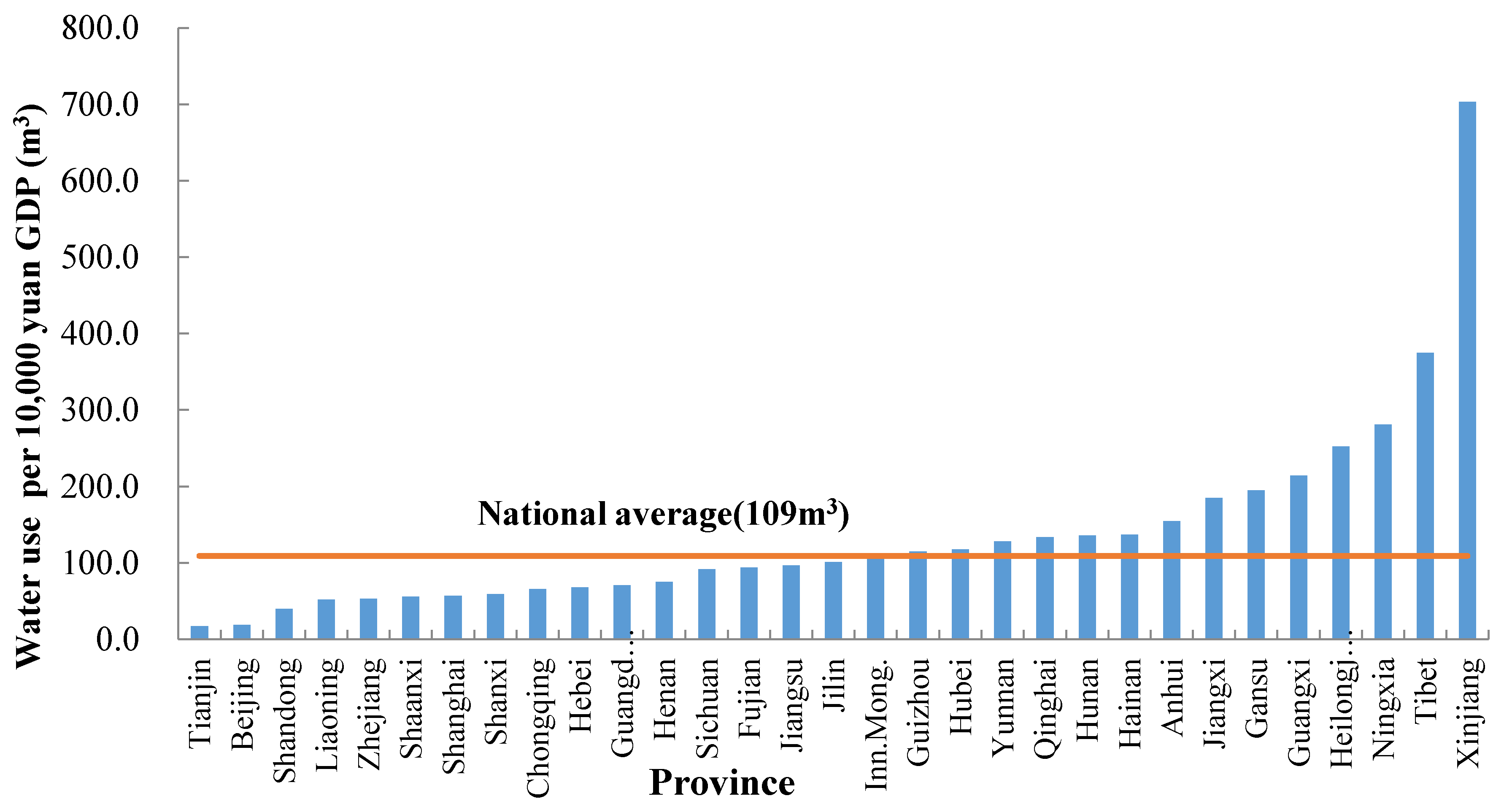
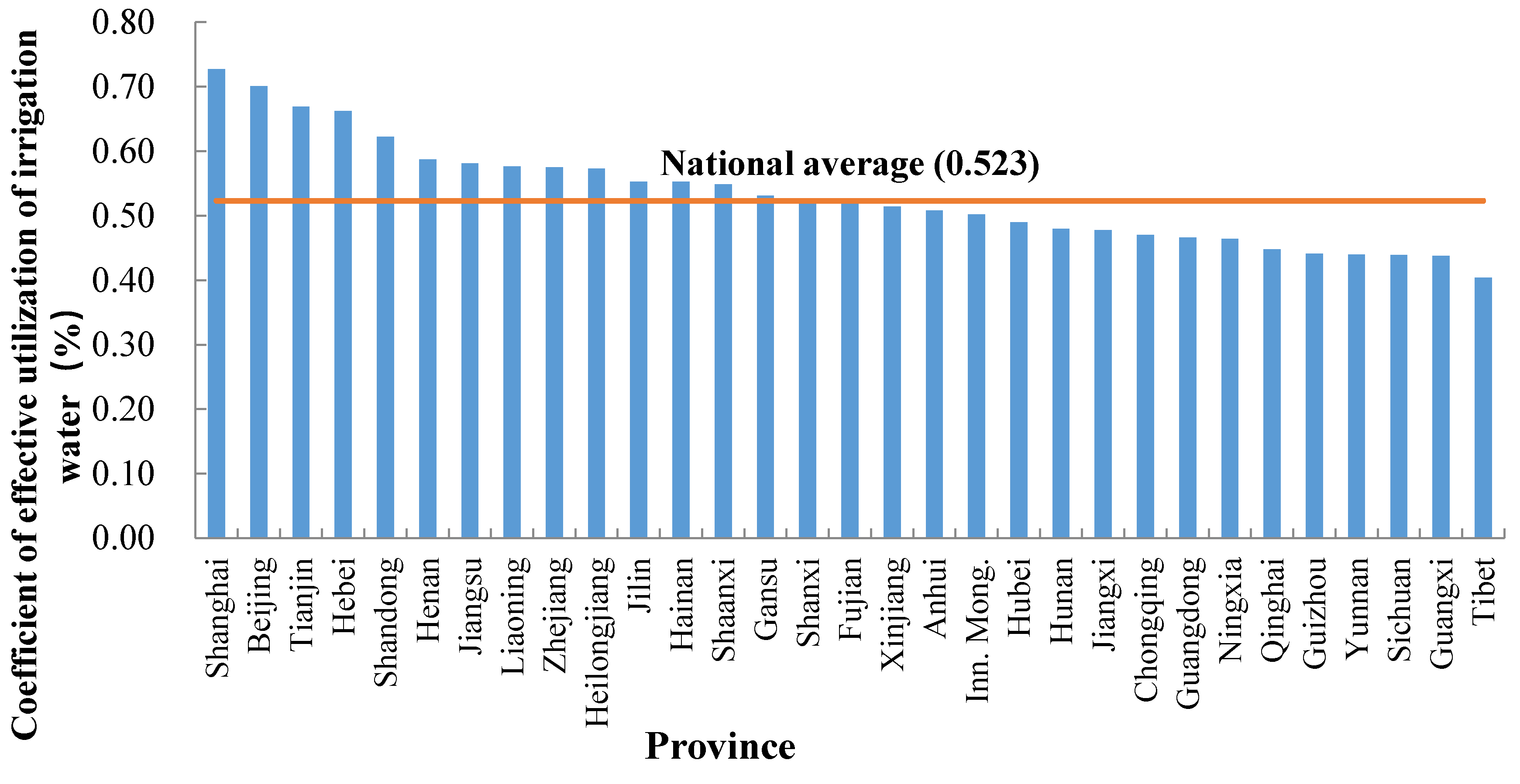
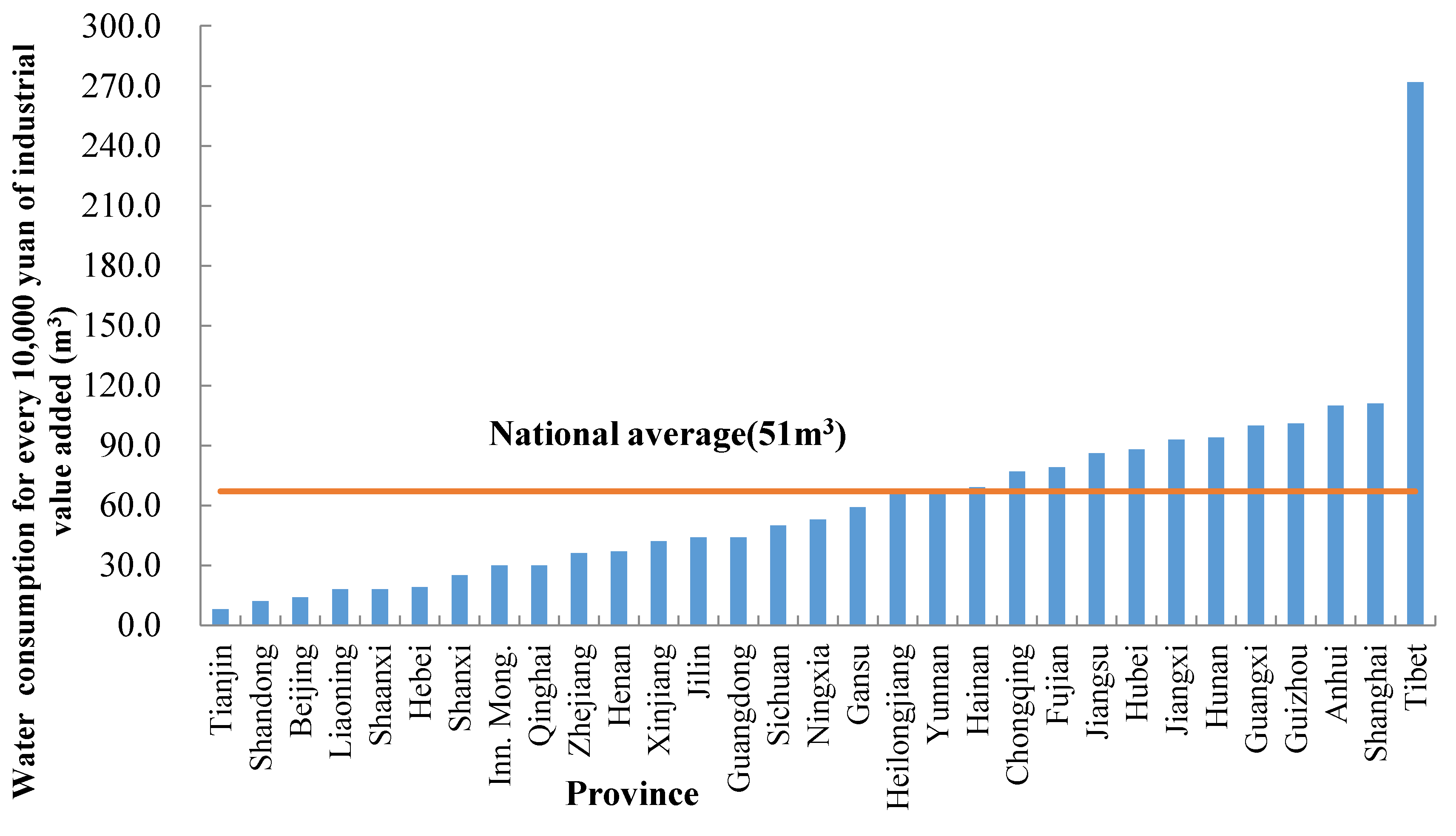
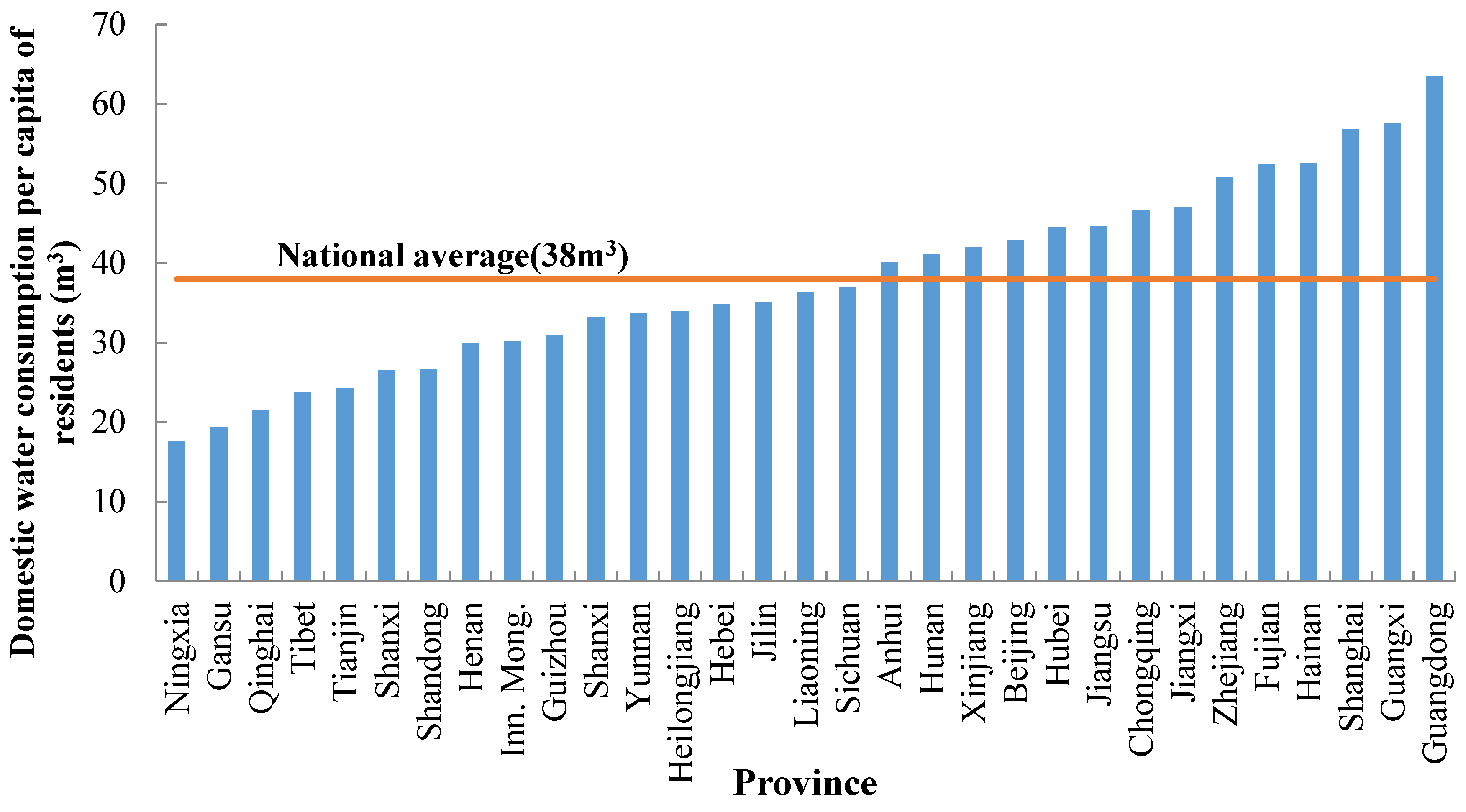
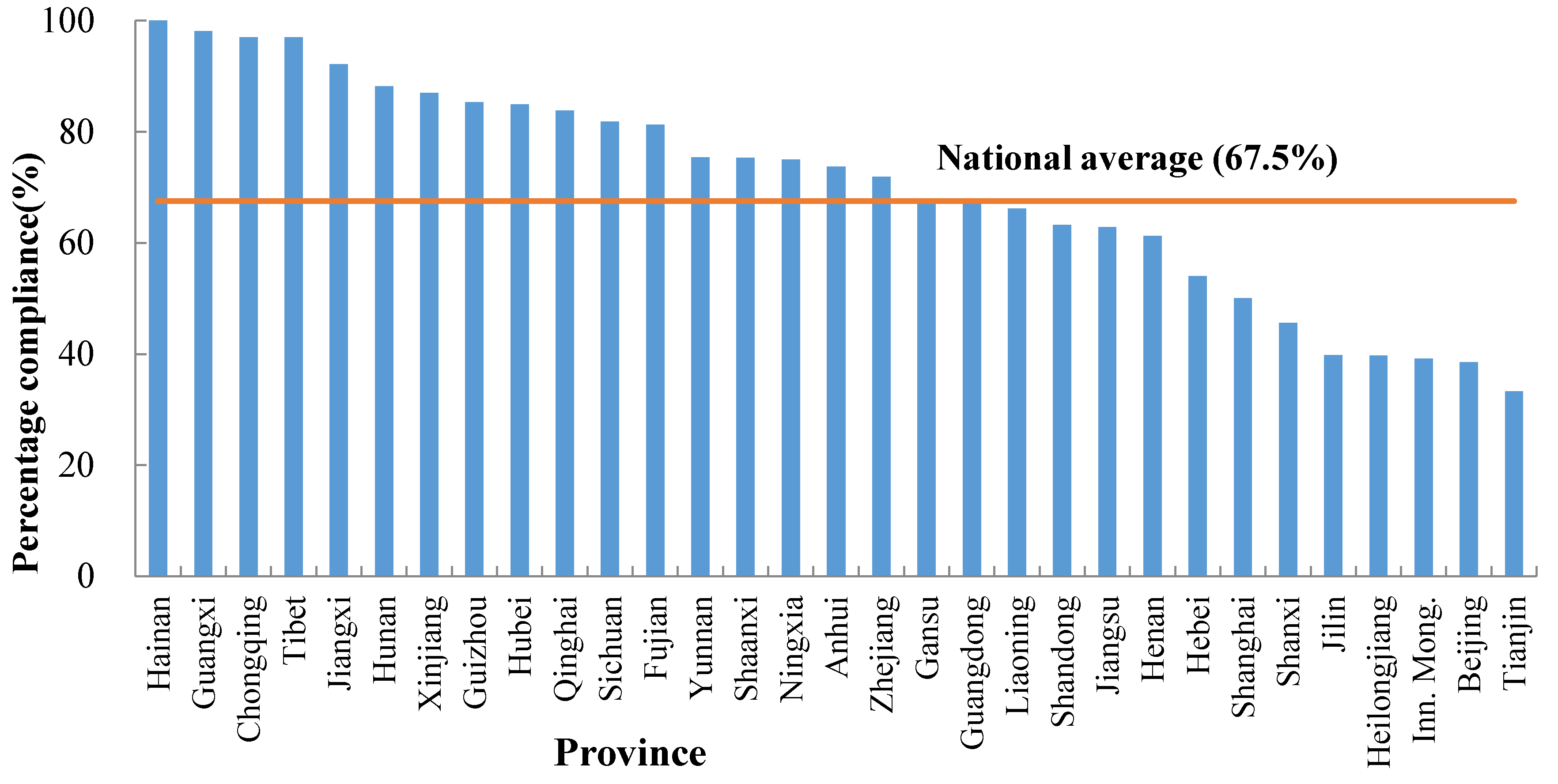
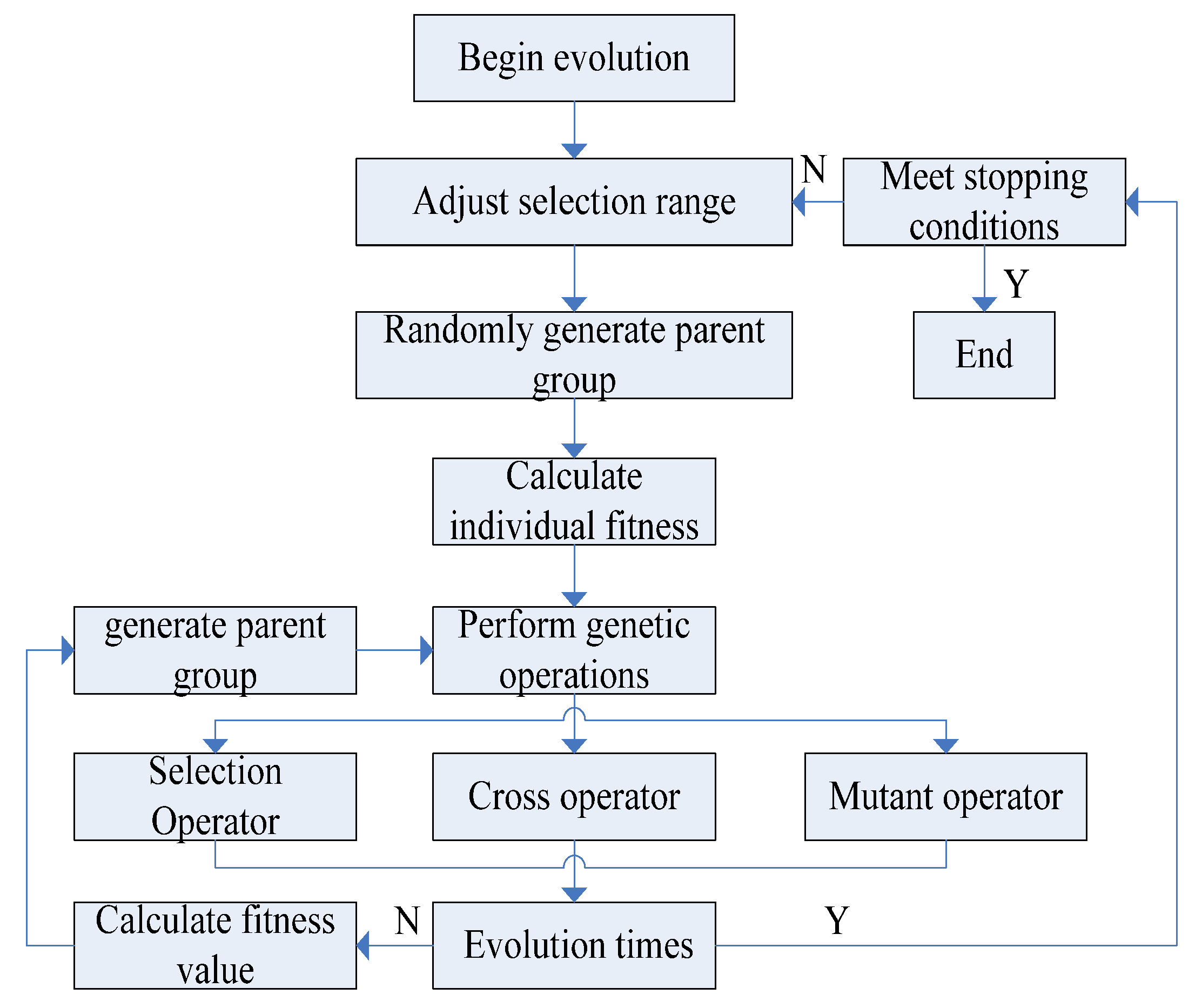
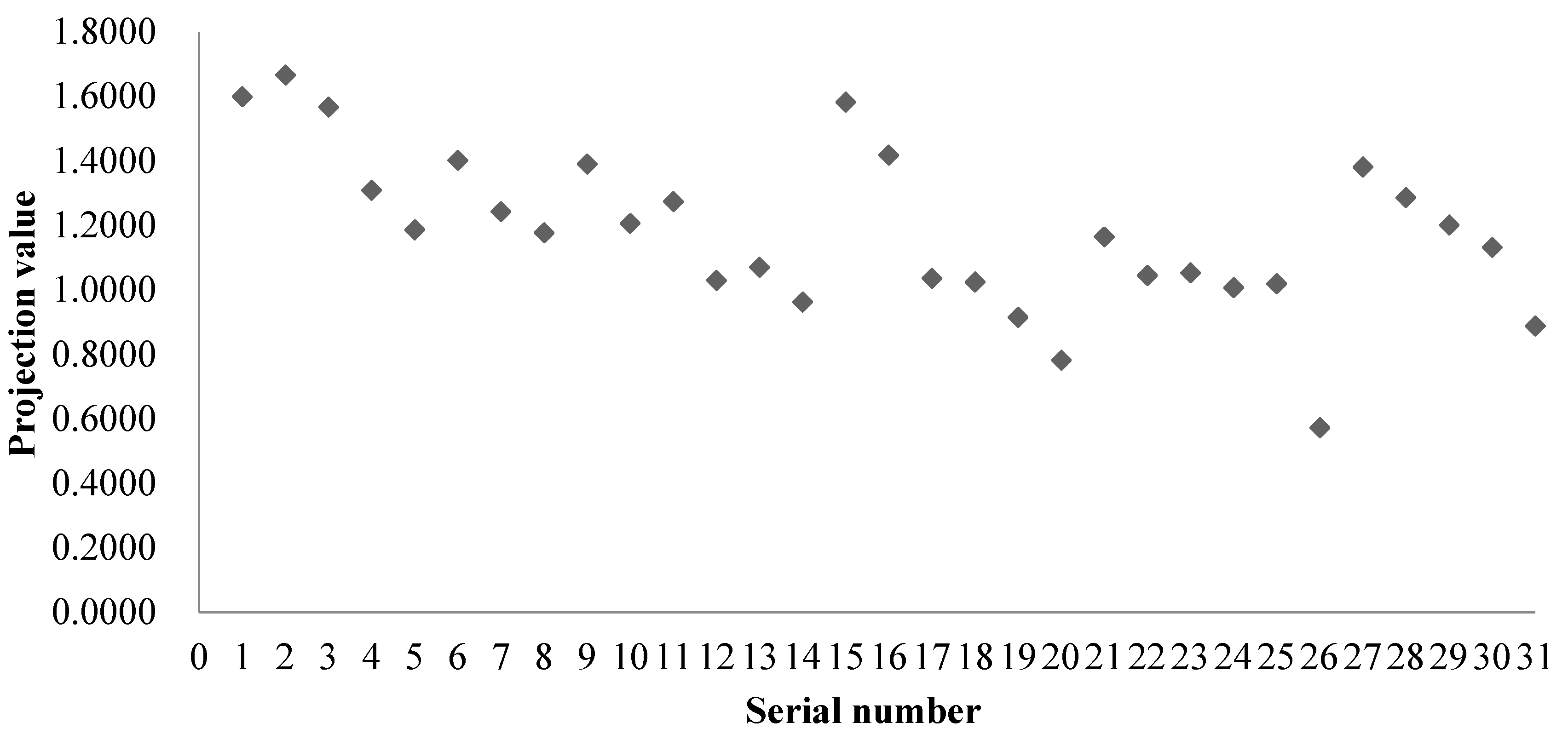
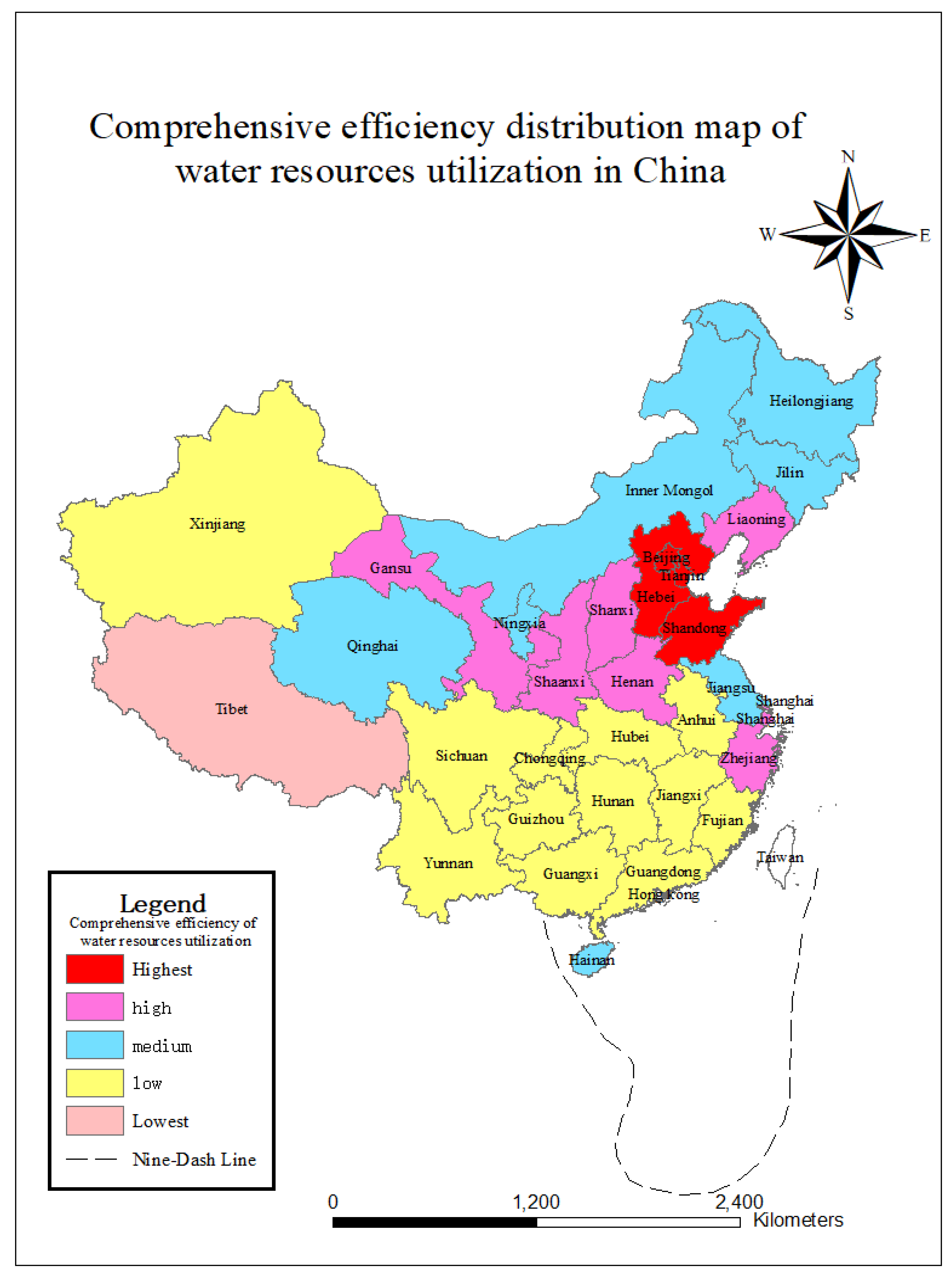
| Sample | Serial Number | Projection Value | Sample | Serial Number | Projection Value |
|---|---|---|---|---|---|
| Beijing | 1 | 1.5993 | Hubei | 17 | 1.0355 |
| Tianjin | 2 | 1.6664 | Hunan | 18 | 1.0245 |
| Hebei | 3 | 1.5675 | Guangdong | 19 | 0.9148 |
| Shanxi | 4 | 1.3088 | Guangxi | 20 | 0.7820 |
| Inner Mongolia | 5 | 1.1866 | Hainan | 21 | 1.1651 |
| Liaoning | 6 | 1.4020 | Chongqing | 22 | 1.0447 |
| Jilin | 7 | 1.2427 | Sichuan | 23 | 1.0527 |
| Heilongjiang | 8 | 1.1770 | Guizhou | 24 | 1.0073 |
| Shanghai | 9 | 1.3900 | Yunnan | 25 | 1.0193 |
| Jiangsu | 10 | 1.2063 | Tibet | 26 | 0.5730 |
| Zhejiang | 11 | 1.2740 | Shanxi | 27 | 1.3807 |
| Anhui | 12 | 1.0291 | Gansu | 28 | 1.2859 |
| Fujian | 13 | 1.0700 | Qinghai | 29 | 1.2010 |
| Jiangxi | 14 | 0.9620 | Ningxia | 30 | 1.1317 |
| Shandong | 15 | 1.5823 | Xinjiang | 31 | 0.8879 |
| Henan | 16 | 1.4184 |
© 2019 by the authors. Licensee MDPI, Basel, Switzerland. This article is an open access article distributed under the terms and conditions of the Creative Commons Attribution (CC BY) license (http://creativecommons.org/licenses/by/4.0/).
Share and Cite
Zhang, W.; Du, X.; Huang, A.; Yin, H. Analysis and Comprehensive Evaluation of Water Use Efficiency in China. Water 2019, 11, 2620. https://doi.org/10.3390/w11122620
Zhang W, Du X, Huang A, Yin H. Analysis and Comprehensive Evaluation of Water Use Efficiency in China. Water. 2019; 11(12):2620. https://doi.org/10.3390/w11122620
Chicago/Turabian StyleZhang, Wenge, Xianzeng Du, Anqi Huang, and Huijuan Yin. 2019. "Analysis and Comprehensive Evaluation of Water Use Efficiency in China" Water 11, no. 12: 2620. https://doi.org/10.3390/w11122620
APA StyleZhang, W., Du, X., Huang, A., & Yin, H. (2019). Analysis and Comprehensive Evaluation of Water Use Efficiency in China. Water, 11(12), 2620. https://doi.org/10.3390/w11122620





